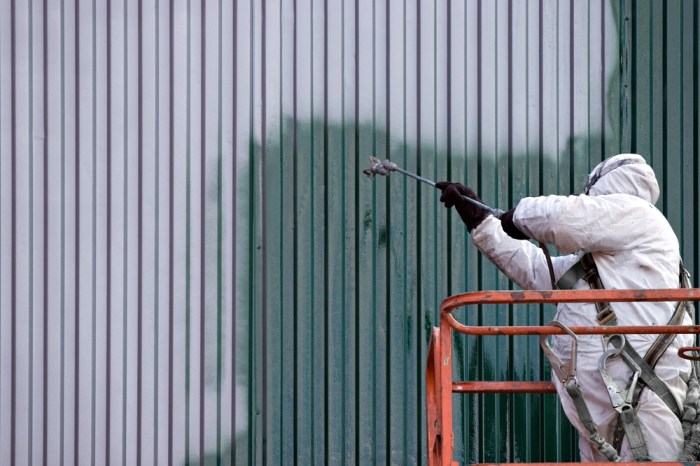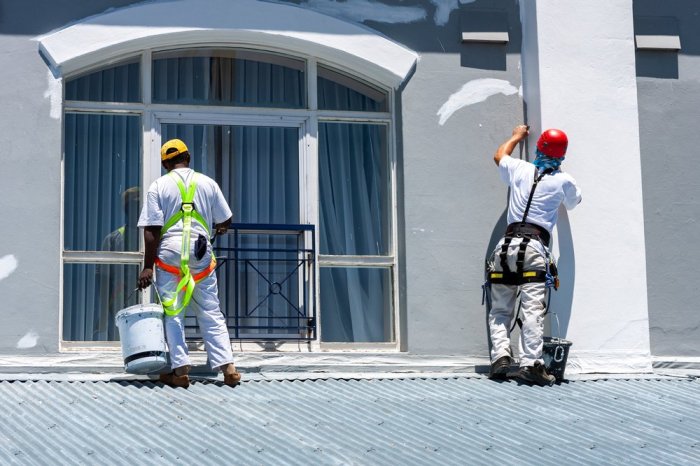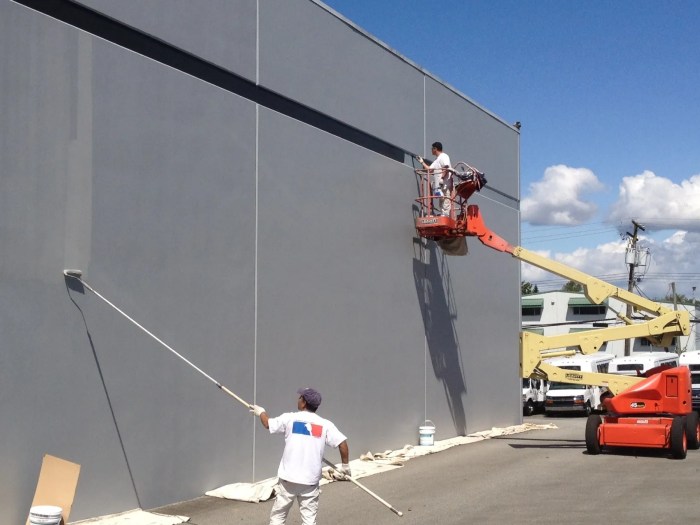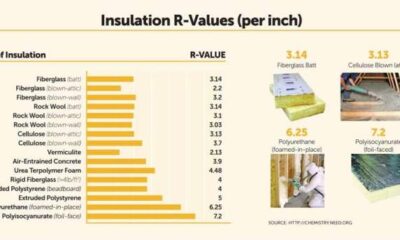Construction
Unlocking the Expertise of Commercial Painting Contractors

Delve into the world of commercial painting contractors and discover the artistry and precision behind transforming commercial spaces. From intricate details to large-scale projects, their impact is unparalleled.
Explore the qualifications, skills, project types, tools, costs, and management strategies that shape the realm of commercial painting contractors.
Overview of Commercial Painting Contractors

Commercial painting contractors play a crucial role in the construction industry by providing high-quality painting services for various commercial properties. These professionals are skilled in transforming the interior and exterior of buildings with a fresh coat of paint, enhancing the aesthetics and overall appeal of the space.
Services Offered by Commercial Painting Contractors
- Surface preparation: Commercial painting contractors are experts in preparing surfaces for painting, including cleaning, sanding, and priming to ensure a smooth and durable finish.
- Painting: They apply paint using various techniques such as spraying, rolling, and brushing to achieve the desired look and finish.
- Color consultation: Commercial painting contractors often provide color consultation services to help clients choose the perfect color scheme for their commercial property.
- Specialized coatings: They also offer specialized coatings for surfaces that require extra protection, such as epoxy coatings for concrete floors or anti-graffiti coatings for exterior walls.
Examples of Commercial Projects
Commercial painting contractors are typically involved in a wide range of projects, including:
- Office buildings
- Retail stores
- Hotels and hospitality venues
- Hospitals and healthcare facilities
- Industrial facilities
- Schools and educational institutions
Qualifications and Skills

To become a successful commercial painting contractor, certain qualifications and skills are essential. These requirements ensure quality work, professionalism, and compliance with industry standards.
Necessary Qualifications and Certifications
- Completion of a high school diploma or equivalent
- Obtaining a contractor's license as required by state regulations
- Completion of specialized training programs in painting techniques
- Obtaining certifications in lead-based paint removal if working on older buildings
Essential Skills
- Attention to detail to ensure precise and clean painting finishes
- Color matching skills to accurately reproduce existing color schemes
- Knowledge of various painting techniques such as rolling, brushing, and spraying
- Ability to work efficiently and effectively to meet project deadlines
Importance of Safety Training and Compliance
Painting contractors must prioritize safety in their work to prevent accidents and ensure the well-being of themselves and others. Safety training includes:
- Proper handling and disposal of paint materials
- Correct usage of ladders and scaffolding to prevent falls
- Understanding of personal protective equipment (PPE) requirements
- Compliance with Occupational Safety and Health Administration (OSHA) regulations
Types of Commercial Painting Projects
When it comes to commercial painting projects, there are various types that require different approaches and considerations. Let's explore the differences between interior and exterior projects, as well as the specific considerations for painting different types of commercial buildings like offices, warehouses, and retail spaces.
Interior vs. Exterior Commercial Painting Projects
- Interior Commercial Painting Projects:
- Focus on painting the inside of commercial buildings such as offices, restaurants, and retail stores.
- Considerations include color choices, durability, and creating a welcoming and professional atmosphere.
- Requires attention to detail, especially in high-traffic areas.
- Exterior Commercial Painting Projects:
- Involve painting the external surfaces of buildings like offices, warehouses, and shopping centers.
- Important considerations include weather resistance, durability, and curb appeal.
- Challenges may include working at heights, weather conditions, and surface preparation.
Painting Different Types of Commercial Buildings
- Offices:
- Focus on creating a professional and inviting workspace for employees and clients.
- Considerations include color schemes, branding, and maintenance.
- Warehouses:
- Require durable and weather-resistant paint to protect the building from elements.
- Considerations include safety markings, visibility, and maintenance in high-traffic areas.
- Retail Spaces:
- Need to reflect the brand identity and attract customers.
- Considerations include color psychology, durability, and creating a unique shopping experience.
Challenges of Painting Large-Scale Commercial Properties
- Logistics:
- Coordination of multiple painters and equipment on-site.
- Efficient use of time and resources to complete the project within deadlines.
- Safety:
- Working at heights and following safety protocols to prevent accidents.
- Ensuring the safety of workers and occupants during the painting process.
- Surface Preparation:
- Properly preparing the surface for painting to ensure adhesion and longevity of the paint job.
- Dealing with different surfaces and materials that require specific preparation techniques.
Tools and Equipment
When it comes to commercial painting projects, having the right tools and equipment is essential for achieving high-quality results efficiently and safely. Commercial painting contractors rely on a variety of tools to complete their projects effectively.
Essential Tools and Equipment
- Paintbrushes: High-quality paintbrushes are crucial for achieving smooth and even finishes on various surfaces.
- Paint Sprayers: Paint sprayers help contractors cover large areas quickly and evenly, reducing painting time.
- Ladders and Scaffolding: To reach high areas and ensure thorough coverage, contractors use ladders and scaffolding for access.
- Drop Cloths and Tape: Protecting surfaces and areas not meant to be painted is essential, and drop cloths and tape help prevent accidental spills and splatters.
- Safety Gear: Safety equipment such as goggles, gloves, masks, and protective clothing are vital to protect contractors from fumes, dust, and potential hazards.
Importance of High-Quality Paints and Brushes
Using high-quality paints and brushes is crucial in commercial painting projects as they ensure better coverage, durability, and a professional finish. Investing in quality materials can also save time and money in the long run by reducing the need for frequent touch-ups or repainting.
Latest Technology and Innovations
Advancements in the painting industry have introduced innovative technologies that benefit commercial contractors. For example, digital color matching systems allow contractors to accurately match paint colors for consistent results. Additionally, the development of eco-friendly paints and coatings not only reduces environmental impact but also provides contractors with more options to meet client preferences for sustainable solutions.
Cost Estimation and Budgeting
When it comes to hiring commercial painting contractors, understanding the cost estimation and budgeting process is crucial to ensure a successful project. Let's delve into the factors that influence costs, the process of estimating project costs, and tips for effective budgeting.
Factors Influencing Cost
- Size and scope of the project
- Type of surface to be painted
- Quality and type of paint and materials
- Accessibility and safety requirements
- Location of the project
Estimating Project Costs
- Start by assessing the size and scope of the project
- Calculate labor costs based on the time required and the number of workers
- Determine material costs, including paint, primer, and any specialized coatings
- Consider overhead expenses such as equipment rental, insurance, and permits
- Add a contingency buffer for unexpected expenses
Tips for Budgeting
- Create a detailed budget plan before starting the project
- Get multiple quotes from different contractors to compare prices
- Avoid making changes to the project scope once work has begun
- Communicate openly with the contractor to avoid misunderstandings
- Monitor expenses throughout the project to stay within budget
Project Management and Timelines

Commercial painting contractors follow a structured project management workflow to ensure successful completion of projects within established timelines.
Typical Project Management Workflow
- Initial assessment and consultation with the client to understand project requirements.
- Creating a detailed project plan outlining scope of work, timeline, and budget.
- Procurement of necessary materials and equipment.
- Preparation of the painting surface, including cleaning and priming.
- Application of paint coats as per client specifications.
- Final inspection and client approval.
Establishing and Maintaining Timelines
Timelines for commercial painting projects are typically established based on the scope of work, size of the project, and client requirements. Contractors set milestones and deadlines to track progress and ensure timely completion.
Strategies for Overcoming Delays
- Regular communication with the client to address any issues or changes in project scope.
- Proactive problem-solving to address challenges that may cause delays.
- Effective time management and resource allocation to stay on track.
- Utilizing experienced and skilled crew members to maintain productivity.
- Flexibility to adjust the timeline as needed while keeping the client informed.
Final Review
As we conclude our journey through the realm of commercial painting contractors, the canvas of possibilities expands. Embrace the creativity, professionalism, and innovation that define this crucial industry.
Top FAQs
What qualifications are needed to work as a commercial painting contractor?
Typically, commercial painting contractors need certifications in painting techniques and safety training to ensure compliance with industry standards.
What are the key factors influencing the cost of hiring commercial painting contractors?
The cost is influenced by project size, materials used, labor required, and any specialized techniques needed for the job.
How do commercial painting contractors manage project timelines?
Contractors establish timelines based on project scope, allocate resources efficiently, and have contingency plans in place to address any delays that may arise.
-

 General2 months ago
General2 months agoSmart Lifestyle Design Tips for Small Urban Homes: Transforming Limited Spaces into Functional Living Areas
-

 General2 months ago
General2 months agoModern Farmhouse Exterior Ideas for Luxury Lifestyle Homes: A Guide to Elevated Living
-

 General2 months ago
General2 months agoCaptivating Title: Interior and Exterior Design Ideas for Wellness Retreats
-

 General2 months ago
General2 months agoAI-powered lifestyle design tools for home planning: Revolutionizing Efficiency and Customization
-

 General2 months ago
General2 months agoLuxury Outdoor Living Spaces for Healthy Lifestyles: Elevate Your Outdoor Experience
-

 Business Tools2 months ago
Business Tools2 months agoThe Best CRM Systems for Lifestyle Coaches and Consultants
-

 General3 weeks ago
General3 weeks agoRevamping Your Space: Kitchen Remodeling Near Me
-

 General3 weeks ago
General3 weeks agoRoof Insulation Materials Comparison: A Comprehensive Guide





